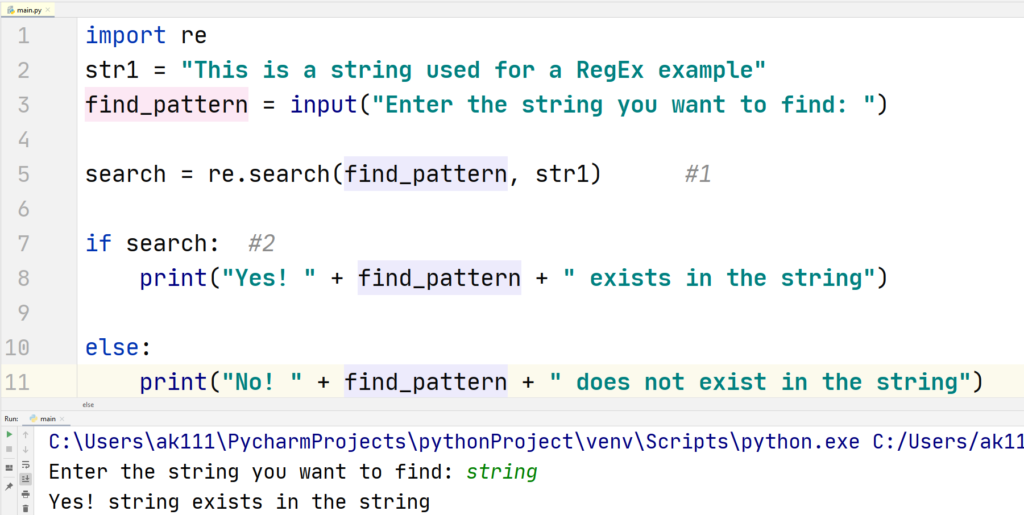
If the first character of the set is ^, all the characters that are not in the set will be matched. TIP: Characters that are not within a range can be matched by complementing the set. Matches any letter from (a to z) or (A to Z) or (0 to 9). # re.search(r'cake$', "Let's get some cake on our way home!").group() # The next search will return the NONE value, try it: re.search(r'cake$', "Cake! Let's eat cake").group() This is helpful if you want to make sure a document/sentence ends with certain characters. # re.search(r'^eat', "Let's eat cake!").group()
PYTHON REGEX MATCH CODE
# However, the code below will not give the same result.

This is helpful if you want to make sure a document/sentence starts with certain characters. Matches any single character except the newline character. You will see both these functions in more detail later. The group function returns the string matched by the re. With the search function, you scan through the given string/sequence, looking for the first location where the regular expression produces a match. Let's check out some examples to see the special characters in action.īut before you do, the examples below make use of two functions namely: search() and group(). For simple understanding, they can be thought of as reserved metacharacters that denote something else and not what they look like. Special characters are characters that do not match themselves as seen but have a special meaning when used in a regular expression. TIP: You don't actually need it for this example however, it is a good practice to use it for consistency. Sometimes, the syntax involves backslash-escaped characters, and to prevent these characters from being interpreted as escape sequences you use the raw r prefix. You will see what this means with special characters.

Such literals are stored as they appear.įor example, \ is just a backslash when prefixed with an r rather than being interpreted as an escape sequence. It changes how the string literal is interpreted. The re module also contains several other functions, and you will learn some of them later on in the tutorial.įor now, let's focus on ordinary characters!ĭo you notice the r at the start of the pattern Cookie? The match() function returns a match object if the text matches the pattern. Most alphabets and characters will match themselves, as you saw in the example. Ordinary characters can be used to perform simple exact matches: pattern = r"Cookie" They match themselves exactly and do not have a special meaning in their regular expression syntax. Ordinary characters are the simplest regular expressions. You can easily tackle many basic patterns in Python using ordinary characters. You will see some of them closely in this tutorial. The re library in Python provides several functions that make it a skill worth mastering. That means that if you want to start using them in your Python scripts, you have to import this module with the help of import: import re In Python, regular expressions are supported by the re module. In the end, there is a case study - where you can put your knowledge in use! So let's regex. You will also learn about compilation flags that you can use to make your regex better. This tutorial also covers some very useful functions provided by the re library, such as: compile(), search(), findall(), sub() for search and replace, split(), and some more. This already seems like a lot, and hence, there is a handy summary table included to help you remember what you've seen so far with short definitions. Next, you'll get familiar with the concept of greedy vs.
PYTHON REGEX MATCH HOW TO
You'll also learn how to create groups and named groups within your search for ease of access to matches. Next, you'll learn about using repetitions in your regular expressions. Then you will see how basic/ordinary characters are used for performing matches, followed by wild or special characters. You will start with importing re - Python library that supports regular expressions. This tutorial will walk you through the important concepts of regular expressions with Python. They help in manipulating textual data, which is often a prerequisite for data science projects involving text mining.

They are used at the server side to validate the format of email addresses or passwords during registration, used for parsing text data files to find, replace, or delete certain string, etc. If you've ever used search engines, search and replace tools of word processors and text editors - you've already seen regular expressions in use. Regular Expressions, often shortened as regex, are a sequence of characters used to check whether a pattern exists in a given text (string) or not.


 0 kommentar(er)
0 kommentar(er)
